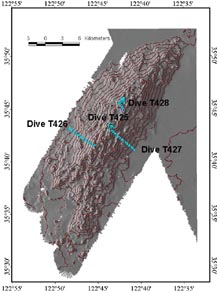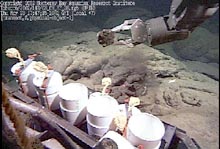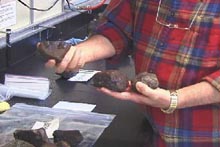
Bathymetric contour map of the Davidson Seamount, showing the dive tracks for each day. Click image for larger view.
Geology of Davidson Seamount
May 23, 2002
David Clague, Senior Scientist
Monterey Bay Aquarium Research Institute
![]() How did the Davidson Seamount form, and how can we tell? (mp4, 5.1 MB)
How did the Davidson Seamount form, and how can we tell? (mp4, 5.1 MB)
Davidson Seamount is one of a group of submarine volcanoes off the continental margin offshore central California between Lat 37.5° to Lat 34.0°. Davidson, along with Guide, Pioneer, Gumdrop, and Rodriguez, are morphologically unlike typical ocean island volcanoes.
All of the seamounts in the group are complex NE-SW trending structures, consisting of parallel ridges separated by sediment-filled troughs. The ridges are constructed parallel to the fossil spreading centers abandoned when the San Andreas fault system formed. On each of these seamounts, a series of knobs are aligned along the ridges; however, craters like those commonly topping oceanic volcanoes are lacking. The lack of collapse craters suggests that the lavas that built the seamounts were never stored in chambers within the volcanoes, as is so common at other oceanic volcanoes.All of the seamounts in the group are complex NE-SW trending structures, consisting of parallel ridges separated by sediment-filled troughs. The ridges are constructed parallel to the fossil spreading centers abandoned when the San Andreas fault system formed. On each of these seamounts, a series of knobs are aligned along the ridges; however, craters like those commonly topping oceanic volcanoes are lacking. The lack of collapse craters suggests that the lavas that built the seamounts were never stored in chambers within the volcanoes, as is so common at other oceanic volcanoes.

The robotic manipulator arm on the ROV Tiburon prepares to place another geological sample in the sample drawer.
Click image for larger view.
The surfaces of the seamounts are built mainly of blocky lava flows, although some pillow lava has been seen on the their deeper flanks. Near the summit, layered deposits of volcanic ash and pyroclastic materials are found. These volcaniclastic rocks indicate mildly explosive eruptions of gas-rich lava at the waning stages of volcanic activity.
Ar-Ar laser fusion ages of mineral separates indicate that Davidson formed about 12 million years ago, making it 8 million years younger than the underlying ocean crust.

Dr. Dave Clague, a geologist at MBARI, compares two volcanic rocks with a terrestrial rock -- all of which were collected near each other on the seamount. It is thought that terrestrial rocks may get transported with kelp holdfasts when the kelp is torn free in winter storms and carried far offshore. Click image for larger view.
The volcanic rocks found on Davidson Seamount are predominantly differentiated alkalic basalt, hawaiite, and mugearite. These evolved lavas are highly viscous (thick and pasty) and form short, thick flows and steep-sided knobby structures at the vents. The high viscosity of these lavas also likely inhibited the loss of gas bubbles, thereby making the eruptions more explosive. The lavas travelled to the surface quickly and carried up rare xenoliths (foreign rocks) of mantle materials as well as a range of coarsely crystallized fragments of lava slowly solidified at depth.
Further details about what we know about the geology of Davidson Seamount were recently published in a paper by A.S. Davis and D.A. Clague, Seamounts at the continental margin of California: A different kind of oceanic intraplate volcanism, Geological Society of America Bulletin, v. 114, p. 316-333, 2002.
Sign up for the Ocean Explorer E-mail Update List.















